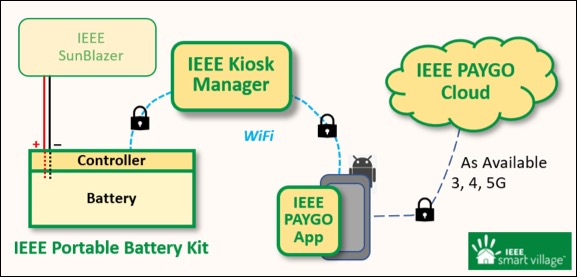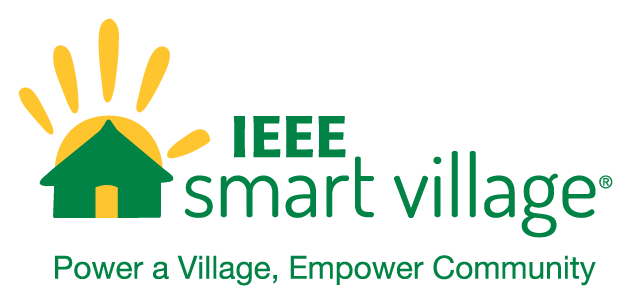ISV Volunteers Develop PAYGO System
The real-world problem of payment for services delivered must be considered in any commercially sustainable utility operation. As such, IEEE Smart Village (ISV) volunteers developed our integrated PAYGO system in consideration of field conditions and operations feedback. For example, the PAYGO system can operate without access to the Internet, which is a need identified in the field.
PAYGO enables a sustained portable power business. This is the primary application of the Portable Batter Kit (PBK) in which a customer effectively “rents” a battery charged by a SunBlazer. A charge serves basic power needs (e.g., safe, clean LED-based lighting; phone charging; radio) for 3 or 4 days, after which time the battery is recharged by the SunBlazer. The ISV technology supporting this business is shown and discussed below. In 2020 the PAYGO system will be extended to include a smart power meter, which will be applied in a microgrid distribution system for homes and small businesses.
PAYGO is supported by the four major ISV-designed components shown in the figure:
- Controller: Open source hardware/firmware integrated in the PBK.
- Kiosk Manager: Micro unit which manages encrypted WiFi connectivity between components and manages a data base.
- PAYGO App for an Android Smart Phone: Serves as the system GUI and as a data wallet. When Internet connectivity becomes available, the phone transfers data to the cloud.
- PAYGO Cloud: System database repository.

While not part of the PAYGO system per se, the SunBlazer serves as the power source to charge/recharge the PBK. Through the Kiosk Manager, a PBK is associated with a specific SunBlazer.
Controller
The controller provides the intelligence within the PBK. It monitors and can communicate battery state and customer account status. Typically, the controller receives a nominal energy value (Ah), which is mapped from a monetary value. If credit is available, the controller allows the battery to be charged to the level of available credit or to a full charge. Similarly, it allows discharge until the end of available credit or full discharge. While not typical, control can also be managed on a time basis.
Each controller contains a unique identifier that is read by the kiosk manager. Each controller/PBK is also tagged with an identifying QR code which can be read by the PAYGO app. As suggested in the figure, the controller communicates with the kiosk manager over an encrypted WiFi link. For power considerations, the controller only enables WiFi when the PBK is being charged. The customer is not charged for this system energy consumption.
Kiosk Manager
The kiosk manager manages encrypted WiFi communications with the PBK controller and the smart phone PAYGO app. WiFi range is approximately 50m. The kiosk manager also maintains a data base for its associated PBKs. The smartphone provides the user interface (UI) for the kiosk manager. Physically, the kiosk manager is a Carambola-based, 5V micro unit.
The kiosk manager typically is associated with a specific SunBlazer. While not attached to it, the kiosk manager is usually near the SunBlazer.
PAYGO App/Android Smart Phone and PAYGO Cloud/Data Repository
As noted, the PAYGO app provides the UI for the system (although the kiosk manager can exchange information without user involvement). It interacts with the kiosk manager via an encrypted WiFi connection. When users fund their accounts, the credit is noted in the PAYGO app from where this information is transferred to the kiosk manager. The latter translates monetary values to available Ah of energy consumptions, which informs the PBK controller. The PAYGO app also includes a QR code reader, enabling the phone to read the controller’s QR code for identification purposes. Other than reading the QR code, all communication between the PAYGO app and the PBK/controller is via by the kiosk manager.
The PAYGO app/smartphone also serves as a data wallet (data storage) for the kiosk manager. When the smartphone can establish Internet access, customer account information is transferred to the PAYGO data repository. We again note that an important feature of the ISV PAYGO system is that it is not dependent on immediate or continuous Internet connectivity to function.

